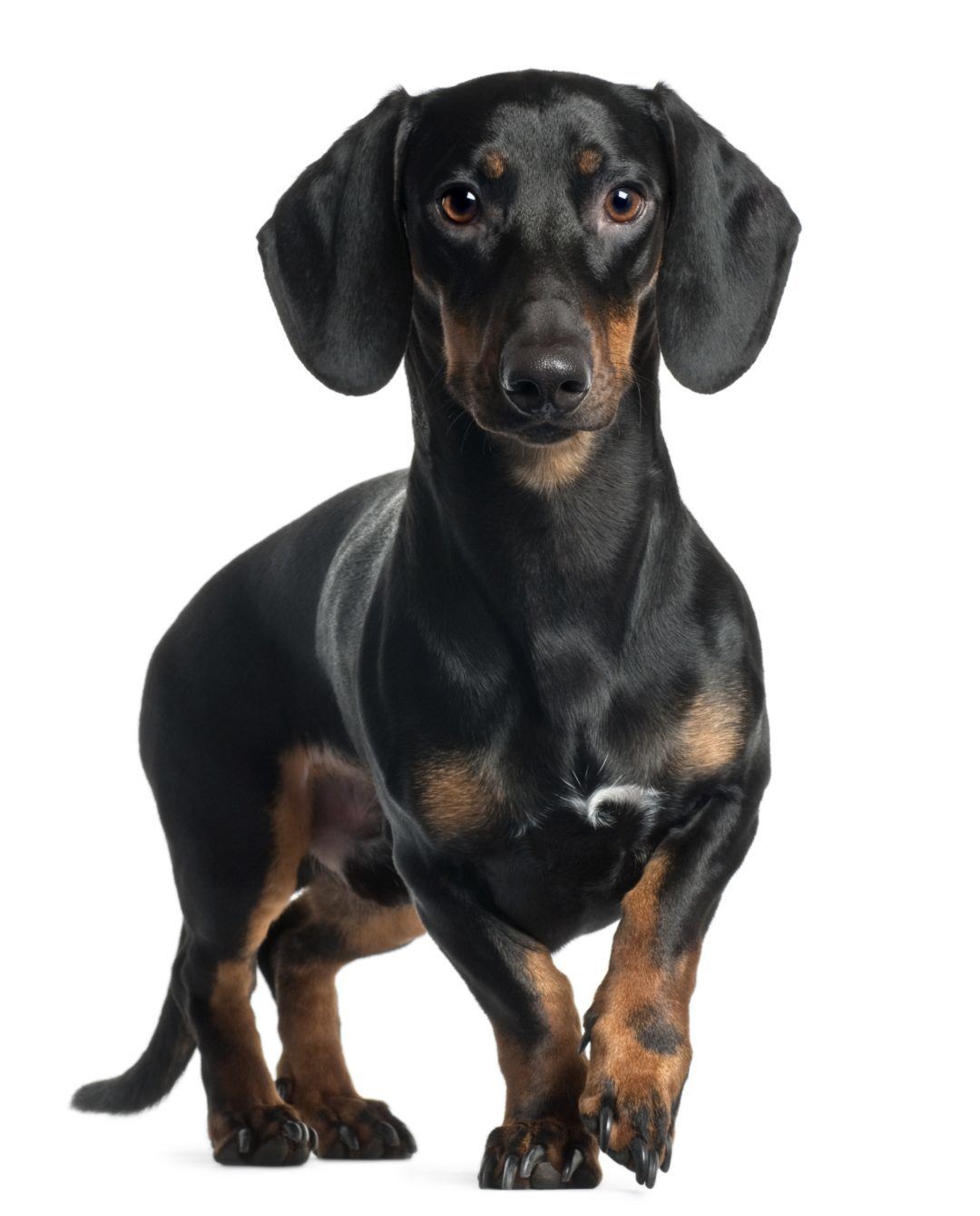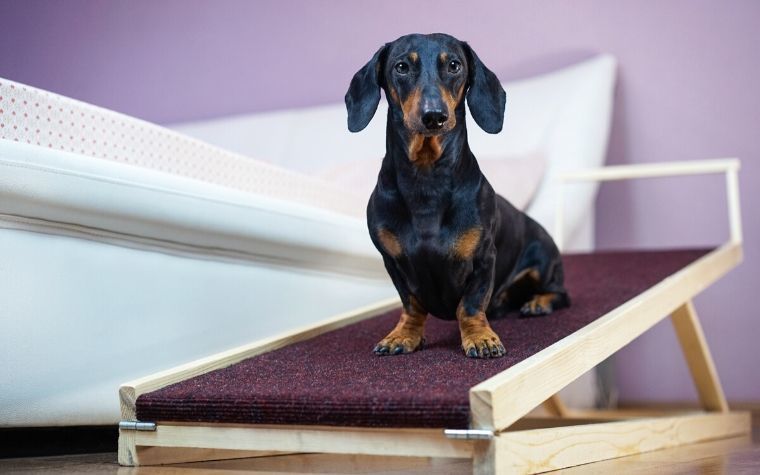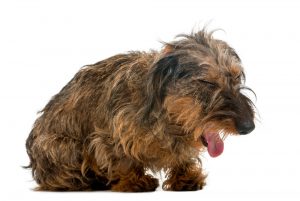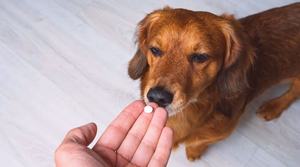
Reviewed & Fact-Checked by
Dr. Chyrle Bonk
Veterinarian (DVM)
Learn more about our Veterinary Review Board »
As our “fur kids” age, like us humans, they may start developing debilitating conditions such as IVDD (Intervertebral Disk Disease).
Some breeds are more susceptible than others. IVDD is more prominent in chondrodystrophoid breeds, or those with short legs and long bodies. It is also more prevalent in older dogs than younger dogs.
Dogs such as Dachshunds, Beagles, French Bulldogs, Labrador retrievers, Pekingese, Pugs, Basset Hounds, Corgis, Cocker Spaniels and more have the highest incidence of this debilitating and painful disc herniation.

Being a chondrodystrophoid breed, the Dachshund is at an increased risk for intervertebral disc disease (IVDD).
What Causes IVDD in Dogs?
The spinal cord is protected by the bony spinal column consisting of vertebrae stacked on top of each other. In between the vertebrae is an intervertebral disc that provides cushion to absorb impact and further protect the spinal cord.
Each disc is made of a fibrous outer ring known as the anulous fibrosus that surrounds a an inner gel known as the nucleus pulposus.
The discs act like both shock absorbers and connectors, and are good at cushioning forces straight up and down the length of the spine, but are not as good as at cushioning twisting or diagonal forces.
Overtime, the repeated concussion, as well as, twisting and diagonal forces, contributes to the outer coating of a disc to harden and rupture. This allows the inner gel to escape out and compress on the spinal cord.
When pressure is put on the spinal cord, it can cause swelling, pain, and even paralysis.
Small to medium-sized breeds appear to be at an increased risk of developing IVDD and in particular those that are chondrodystrophoid. Dachshunds are at the greatest risk of developing IVDD more so than other breeds.
Studies show that the Dachshund are about 10x as likely to develop IVDD, and roughly 20% of them will be affected.
Does a Dachshund's Long Back and Short legs Cause IVDD?
A misconception is that the Dachshunds’ long back is the cause of IVDD.
Chondrodystrophoid breeds, like Dachshunds, have an accelerated form of intervertebral disc degeneration. This predisposition results in herniation of the disc or disc displacement known Type I IVDD.
The main culprit behind IVDD in Dachshunds is the gene they carry that causes them to have short legs. That same gene known as chondrodystrophy causes the gel in the disc to become calcified and thus lose its elasticity. This makes it more prone to rupture.
Almost one quarter of all Dachshunds will develop IVDD during their lifetime with the majority of them presenting disc degeneration between ages 3-7 years. Age 4 is the most common age of occurrence.
Another remarkable finding, is that chondrodystrophoid breed dogs (CD) with a shorter spine, larger height and a larger pelvic area are more susceptible intervertebral disc herniation.
Larger dogs, like Labrador retrievers, have biomechanical and physical factors that are different from those of Dachshunds, yet, they can still develop Type II IVDD between ages 5-12 years. So, the propensity of developing IVDD isn't completely linked to a dog's back or leg length.
Signs of IVDD in Dogs

Please see your family vet if you notice any early signs of Intervertebral disc disease in your Doxie
Signs of IVDD in dogs can occur at any age. Type I IVDD usually shows up in younger adult, while type II may be later in onset.
The main signs of IVDD in dogs are that should be a red flag for owners include:
- Stiff in gait or even just standing
- Paraparesis or Paraplegia
- Tremors
- Anxious behavior
- Inability to walk
- Knuckling
- Loss of deep pain
- One or more feet are sluggish compared to the others
- Having difficulty in lifting their head or holding the neck low
- Losing interest in food
- Back legs not working
- Limping on one or both front limbs or all four limbs
- Back pain characterized by arching in the back
- Difficulty getting up or jumping
Important
If you see any of these signs displayed in your Dachshund, or any dog, act straight away. Contact your vet and have him checked out.
How To Treat IVDD
If diagnosed during its early stage, your dog may be prescribed non-steroidal anti-inflammatory medications, corticosteroids, muscle relaxants, acupuncture and strict bed rest.
Where IVDD has progressed, surgery coupled with physical therapy may be required.
Dr. Chyrle Bonk, DVM states that:
Conservative treatment with potent anti-inflammatories and cage rest will help to decrease inflammation and swelling around the spinal cord in order to regain normal function. This approach is more successful in dogs that still have some ability to walk and feel pain.
It’s important to note that many dogs with IVDD can be managed well without undergoing surgery. This is especially true if the disease is caught and treated early. Pet owners need to be consistent and meticulous about strict crate confinement during the entire recovery period.
Where IVDD has progressed, surgery coupled with physical therapy may be required.
Surgery involves removing the herniated disc and decompressing the spinal cord.
Surgery is successful in the majority of the dogs with acute disc herniations, and most dogs take 6-8 weeks to recover.
Those with Hansen Type II take a little longer to recover. After surgery your dog should take it easy and avoid running, jumping, and hoping on and off furniture.
Physical therapy has proven beneficial if done immediately after surgery to help regain strength and function.
Important
If your dog receives pain subsiding medication, be aware that the symptoms may be masked or you may think your dog is fully recovered since they begin to show improvements. Don’t be fooled by the immediate effects of the medication and don’t become lax about his strict cage rest and limiting his mobility during this period. A lot of well-meaning owners fall foul of this and as a result slow down their dog's recovery.
On the downside, the recurrence rate is around 50% especially in the case where owners have become lax during the recovery period. Excess weight and obesity can also play a role in whether a dog relapses or not.
Dog IVDD Surgery Cost
The cost of neurosurgery for Hansen Type I IVDD cases (known as slipped disc) range between $3,000 and $4000.
This includes the cost of surgery, consultation fees and overnight fees. Be prepared for follow up costs that include radiography and CT imaging after surgery, meds and vet follow-ups.
For Hansen Type II IVDD surgery, the costs are higher.
Finding affordable insurance for your Dachshund is imperative - since there is a one in four chance your dog is going to require treatment.
Physical Therapy For Dogs with IVDD

Regular physical therapy is recommended post-surgery. Since studies show it has been successfully used in both speeding up recovery and reducing the recurrence rate.
This type of treatment involves a series of acupuncture, physiotherapy, electrostimulation, massage or laser treatments.
Ask your vet to develop a recovery plan involving physical therapy after conservative or surgical intervention.
IVDD Recovery for Dogs
- Post-surgery or any treatment received for IVDD, a comfy and well-padded bed is a must.
- Dogs that can't walk right away will need to be turned regularly to help prevent pressure sores known as decubital ulcers.
- If your dog is overweight, your vet will prescribe a weight loss program that owners must not deviate from. Keeping his weight down ensures the rate of recurrence is also minimized. Avoid giving him leftover scraps and sugary/high-fat treats since these are the main culprits behind gaining weight.
- While recovering from intervertebral disk disease, dogs should have minimal mobility. Using an indoor dog playpen or a crate is best as it limits the space to move around in.
- Using a harness or a sling instead of a dog collar, reduces the strain on the damaged, or recently repaired, vertebrae and keeps the spinal column aligned properly.
- Limit his exercise during the recovery period ensuring he doesn’t run or jump freely, since these sudden movements can exacerbate spinal damage. The types of exercise that your dog is encouraged to do post- IVDD is swimming or other passive range of motion as these are safe for the joints and spine.
- To limit jumping on and off furniture or cars, buy an indoor pet ramp or steps for him. These are inexpensive yet highly effective for reducing pressure on the spine and hips.
- Finally, a doggie stroller is a great option for longer walks for when he gets tired or his mobility is impacted in the short-term.
It's important that owners use the right pet equipment for their ailing pup.
IVDD Prevention in Dogs
Of course, not every short-legged, long-backed dog is doomed to suffer this debilitating and painful disc disease, and we don’t want to dissuade owners from adopting or buying a Dachshund puppy out of fear. But caution is definitely warranted since evidence suggests that IVDD is a genetic condition.
To reduce the chances of getting a dog that predisposed to IVDD, be sure to buy a puppy with no IVDD family history. If one parent had calcification then the puppy has a higher chance of developing IVDD. If both parents had it, then the risk is even greater. Breeders can find out if a puppy is likely to develop IVDD after 18 months old by performing an x-ray.
What if you already have a puppy with family history of IVDD? To better their lives, owners can do a several things, although nothing is guaranteed.
Don’t let your dog get overweight, keep him slim. The excess weight puts further strain on the vertebrae and discs. I know it’s hard to resist your dog begging for a treat, but treats throughout the day add up to lots of calories. A good substitute to high-calorie dog treats, are carrots sticks or rice cakes.
Another thing pet owners should do is to keep them away from the kitchen while cooking. Scraps and dinner leftovers in addition to their daily dog food may result in your dog gaining unnecessary weight.
Avoid certain movements to minimize the possibility of injury. Limit your dog from overzealous jumping or vigorous tug-of-war games that can twist the spine. This includes jumping on or off the couch, on and off an SUV or higher vehicles and avoiding long or steep flights of stairs. A pet ramp is great for preventing twisting of the spine or any falls that may damage his spine.
Foods rich in lechitin, found in tofu, egg yolks, beef, liver, spinach and wholegrains can help in supporting the fatty case that surrounds the nerve cells of the spinal cord.
Crate training your dog is important. If your dog suffers a minor trauma, strict crate rest is often prescribed to ensure limited mobility if you’re not around.
Mild forms of exercise for fun and as a preventative measure is encouraged. Daily walks and plenty of activity is key to keeping your dog’s muscles strong and stable so that they can continue supporting the spine. Don’t shy away from playing in the park, brisk walks, hiking, earth-dog competitions or even field trials – these are activities that will keep them in shape and strengthen their back.
What's on the Horizon for Treating IVDD in Dogs?
The video below, is a good example that there is hope in the future for improved and alternative treatments that are less invasive and have a higher success rate.



